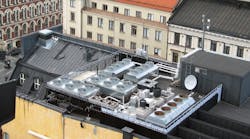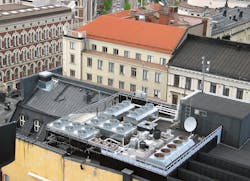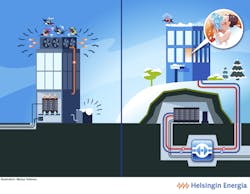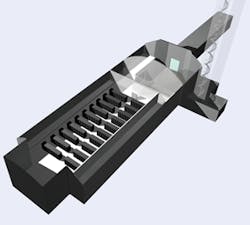Helsingin Energia's traditional electricity business operations are geographically limited to within the borders of Finland and district heating and cooling sales within Finland's capital city, Helsinki. Electrical energy is supplied to approximately 400,000 customers in different parts of the country, and district heat is supplied to some 400,000 residents in the capital. Helsingin Energia (HE) is a public utility owned by the city of Helsinki. In general, the heating and cooling customers are located relatively close to the generating plants.
HE, which has a target to achieve carbon-neutral production by 2050, is actively involved in the development of new technologies. To achieve this objective and other similar technologies, the utility has invested in district cooling and heating networks in addition to heat-recovery systems. One specific achievement HE developed is an innovative solution to cool data centers by using the waste heat from computers to heat other city buildings and supply hot tap water to the residents of Helsinki.
The first use of this solution was implemented in cooperation with the information and communications technology service provider Academica (now part of TelecityGroup). Heat is directed, for utility distribution purposes, in a controlled manner that effectively reduces the carbon-dioxide emissions produced by the cooling process by up to 80%. Through this achievement, HE has become an energy utility that can facilitate and deliver a green solution that enables its IT customers to focus on their core business operations.
Mission and Expectations
HE has already built district heating and cooling facilities for key customers; in fact, it is the first service provider to be able to deliver the facilities to the warehouse-sized data centers. Data centers consume an estimated 1% of the total electrical energy consumed globally; therefore, this relatively new industrial sector has huge development potential. Traditional cooling systems installed in data centers discharge air at a temperature above 120°F (49°C) on cold winter days, so there is an opportunity to use this waste heat.
The maximum power requirements (MPR) for data centers were considered so large the utility found it difficult to appreciate the reasons for the seemingly excessive demand for energy. It was difficult to believe the energy requirements for these modern centers exceeded that required to supply a residential district.
As a result of the consolidation of data center operations and the sharp increase in their size and power demand, data centers have become attractive customers for HE. Most of the district cooling and heating infrastructure in Helsinki is already built and, with small additional investments, the utility can serve the data center customers.
New, modern data centers require electrical and cooling supplies of a size that only large utilities can reliably deliver in practical terms. Data center regulations specify a high level of physical safety and an uninterrupted delivery of critical connections. The existing underground facility and supply opportunities available through the existing underground tunnels in Helsinki offer the highest possible physical safety and security of supply for these important customers.
Actions and Goals
HE aims to offer a maintenance-free solution that removes all customer concerns regarding its own electricity and cooling production facility, without any of the worries that customers who own electricity and cooling production can create. The utility offers a green solution with more favorable start-up and acceleration costs than those of a conventional system.
A green solution does not always mean it is more expensive. With the district heating and cooling technologies, the customer, in fact, reduces operational costs. The conventional condensing units normally installed on top of buildings take up a lot of space, are noisy and are not very attractive. HE considered district cooling for the cooling of data centers because this solution is totally silent and inconspicuous, and its output can be increased seamlessly at any time. Moreover, this solution, which has a carbon footprint that is only a fraction of the alternative system, offers the opportunity for customers to use 100% of their electricity energy for computing operations. This will effectively reduce the customer's MPR, which, worst case, will result in one-half the MPR being used to operate the cooling equipment.
A district cooling system has a considerably longer technical service life, and the benefit for customers is that HE is fully responsible for production, including maintenance and risks.
HE is now in a position to offer customers with data centers these attractive benefits through its service:
-
It is a municipal, local energy utility committed to long-term operations and able to offer long-term contracts to customers.
-
Energy prices and other costs can be forecast with reasonable accuracy for the life cycle of the plant.
-
Finland has a safe and stable climate, soil and political situation.
-
HE realizes that advanced industrial infrastructure and high security of supply for electrical energy are important to customers.
-
HE has adopted a positive attitude toward foreign companies and investors who are able to benefit from excellent data communication links to neighboring countries and the rest of the world.
Energy Savings and Environmental Benefits
Electricity, heat and cooling are produced in a single process. The use of waste heat, coupled with an extremely high efficiency rate, enables the delivery of favorably priced cooling energy to the customer. District cooling is an eco-efficient urban energy, as 80% of the production is based on resources that would be otherwise wasted or unused. The customer only pays about one-fifth of the price for the cooling energy, and the customer's fixed and variable costs are very competitive for a solution that is both green and eco-efficient.
The power usage efficiency limit value previously has been 1.0, but this new heat-recovery process enables values below 1.0, thereby establishing zero as a new limit value for the power usage efficiency.
HE's district cooling is produced in 15 independent production units located in three different production plants. The methods of production are as follows:
-
Heat pump
One unit of electric energy produces five units of heat and cooling energy. Therefore, the efficiency rate is very high because electric energy is returned five-fold in the form of heat and cooling. The waste heat of the servers is recovered with a heat pump. This heat is transmitted to the district heating network to heat buildings and supply customers with hot water.
-
Absorption technology
This is used for creating district cooling in the production of electric energy using heat energy that would otherwise be unused waste heat. The absorption machines are operated in the summer when the seawater is too warm for free cooling. Electrical energy is consumed only for the internal fluid circulation.
-
Free cooling
District cooling can be produced from cold seawater from November to May, when the seawater temperature is below 45°F (7°C). Electrical energy consumed only for the internal fluid circulation during this period is reduced.
Heat-Recovery System
The heat-recovery system at HE's disposal is the result of a long-standing proven process, but the technology developed by the utility can, in principle, be used anywhere. The cooling production plants do not produce noise, smoke or emissions. When the conventional electrically operated cooling systems are phased out or replaced with district cooling, the total energy consumption energy will decrease. This should be taken into account in the evaluation of environmental impact and benefits. Use of this technology elsewhere will probably require the construction of district heating and cooling networks.
Cooling production must be based on local resources, which can include purified wastewater, industrial waste heat or cold seawater, if it is available. District cooling also can be used for building-specific cooling, in which case the network investment costs are distributed among a larger group of users. For example, shopping centers and office buildings easily require megawatt-sized cooling supplies. District cooling also is suitable for use in smaller data centers. Larger-scale projects have advantages in the form of security of supply, utilisation of waste heat efficiency and competitive costs, and it is profitable revenue stream for HE. In 2010, HE had a net turnover of 716 million euros with a profit of 245 million euros.
A change in the form of energy results in energy losses. The closer the energy is used to its original form, the fewer the losses. Electricity is an extremely highly refined form of energy with losses being created in its production, transmission and voltage changes. Using electricity for heating or cooling is not economical if there is a local source of suitable unrefined energy available, such as waste heat or cold seawater. Therefore, energy losses are smaller if the fuel is converted into direct heat or cooling.
Environmental Benefits
The easiest way to reduce the environmental impact is by saving energy because all energy production has an impact on the environment. The cooling of data centers with district cooling is a significant energy-saving measure. It does not consume the customer's electricity and 80% of the production cost of cooling is based on resources that would otherwise remain unused or be wasted.
The investment and installation costs of district cooling are competitive compared to conventional compressor chillers. Customers do not need to invest in individual cooling systems and coolers. District cooling improves the reliability of cooling, as these district cooling plants operate 24 hours a day, seven days a week throughout the year.
The estimated emissions of a 1-MW data center introducing district cooling will be significantly diminished annually:
-
3,000 MWh of primary energy compared with alternative cooling solutions
-
Emission of 600,000 kg of carbon dioxide
-
Equivalent to the carbon-dioxide emissions of a passenger car driven 6 million km (3.73 million miles).
Additionally, compressor-operated cooling equipment contains refrigerants, including the HCFC compounds classified to cause atmospheric ozone depletion. No refrigerants are used by the data centers using district cooling.
System Reliability
New modern data centers require electrical and cooling supplies of a size that only energy utilities can reliably supply. As data centers require a high level of physical safety and an uninterrupted supply of electrical energy, these critical criteria are crucial, so the infrastructure comprising underground tunnels offers the perfect solution. In Helsinki, a city built on solid granite, there are 60 km (37.3 miles) of tunnels, some 20 m to 120 m (66 ft to 394 ft) below ground level, with 120 upright shafts or entrances that are used for district heating and cooling pipes and electricity cables. The lowest point in the tunnel network is the underground storage facility for coal beneath the Salmisaari power plant. Currently, the length of tunnels used for district cooling is 10 km (6.2 miles).
Helsinki's tunnels are sufficient in size to accommodate data centers and also provide a convenient way to route data cables to different parts of the city. Furthermore, Helsinki has more underground tunnels that accommodate the metro, road traffic and wastewater facilities.
At present, the reliability of the electricity distribution network in Helsinki results in the probability a customer will experience an outage lasting between 20 minutes and 60 minutes once every five years. HE's planned network automation scheme is expected to reduce this interruption time to a few minutes within a few years.
Already in view of the city's reliable distribution network, some of the utility data center customers have abandoned plans to install standby generators, while others have decided to halve the number of standby generation units installed. It should be noted that the installation of every extra level of redundancy in the form of a generator and uninterruptible power supply in data centers can increase the customer's electricity consumption and uninterruptible power supply by 10%. Therefore, the existing reliable distribution network that is now reducing the energy wasted is effectively an environmentally friendly network.
By positioning new data centers on sites close to generating stations or in close proximity to grid substations, HE is confident that, provided the Nordic transmission system continues to comply with the current system reliability standards, there will be few or no failures in supply. It has been 35 years since Finland's transmission system operator, Fingrid, experienced a major outage.
Uspenski Project
In 2008, Academica, who was concerned the electricity supplies to its existing data centers were proving inadequate, sought advice from HE on the ideal location to site a new data center. This customer required a secure source of supply that was cheaper and greener. The solution was the installation of a new data center in an underground cave, a former World War II shelter that could be supplied with district cooling at one-fifth the cost of electrical energy.
Commissioned in early 2010, this data center is positioned underneath the city's peak, immediately beneath the Uspenski Cathedral that faces the Finnish president's castle. Academica named this new facility a “butik,” meaning a showroom data center. The heat output from all of the district heating customers provides heating and warm water to thousands in new 80-sq m (861-sq ft) city apartments.
Acknowledgment
The author would like to express his gratitude to his colleagues and superiors: Markus Lehtonen, Martti Hyvönen, Markku Hyvärinen, Marko VJ. Riipinen and Rauno Tolonen, all from Helsingin Energia, Matti Roto from Academica and Marko Jalkanen from YIT Construction for their guidance, contributions and support with this interesting project.
Juha Sipilä ([email protected]) is a project manager at Helsingin Energia. He has a master of science degree in mechanical engineering from Helsinki University of Technology and is a Ph.D candidate at Aalto University, Espoo, Finland. He has worked at Helsingin Energia's engineering office since 2008 with particular interest in the development of combined heat and power applications. Sipilä's current duties include launching the new business field of providing facilities for green data centers, and his areas of expertise include the establishment and development of energy-efficiency-enhancing but commercially feasible solutions. He has also worked in technology collaboration project to test, develop and implement smart energy solutions in the city of Helsinki.
Companies mentioned:
Helsingin Energia | www.helen.fi
TelecityGroup | www.telecitygroup.fi





